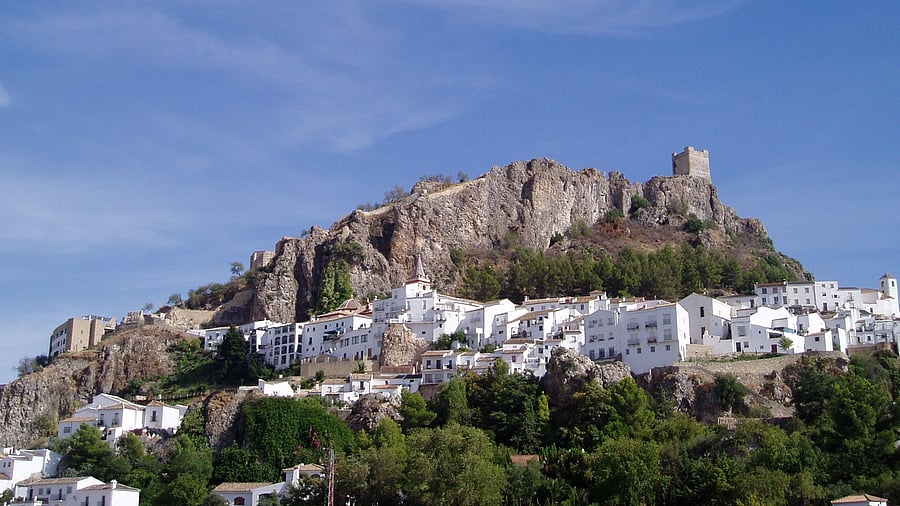
Zahara de la Sierra is a municipality in one of Spain’s most picturesque Peublos Blancos or white towns in the Cadiz province. I
Credit: Wikimediacommons
As we journey through Andalucía, Spain, we’re greeted by breathtaking landscapes: rolling hills adorned with silver-leafed olive groves, vibrant yellow sunflower fields, and quaint villages gleaming in white against the azure sky. These are the Pueblos Blancos, or "white towns," strategically perched on clifftops. The tradition of whitewashing homes dates back to Roman times, utilising slaked lime as a natural disinfectant that kept houses cool during the sweltering summers. This practice gained prominence during the plague of the 14th century, leading to the whitewashing of both exteriors and interiors.
Many of these villages originated as Moorish strongholds, showcasing a captivating mix of architectural styles influenced by the Moors and Gothic elements, alongside the unique Mudejar style, which was crafted by Muslims for Christian patrons. While some towns, like Olvera, buzz with tourists, others offer a tranquil retreat, characterised by quiet squares and charming residents.
Our destination was Zahara de la Sierra, one of Spain’s most picturesque Pueblos Blancos, located in the Cadiz province. With a population of around 1,300, this small town is a mere 30-minute drive from Ronda. Zahara clings to a dramatic crag, its whitewashed houses spiralling down steep hills, interspersed with narrow alleyways, lookout points, and historic squares. Recognised as one of Spain's most beautiful villages, Zahara has a storied past that played a crucial role in the Moorish expulsion from Andalucía.
In the 15th century, Zahara was recaptured by Christians, only to fall back into Muslim hands in 1481. This led to the Granada War, ultimately restoring Zahara to Christian control two years later. The village served as a battleground for control of a crucial tower that belonged to the last Muslim kingdom.
Nestled at the northern edge of the UNESCO Biosphere Sierra de Grazalema Natural Park, Zahara boasts stunning hiking trails through a landscape rich in wildlife, including golden foxes and weasels. Among its natural treasures are the rare Spanish firs, often referred to as "living dinosaurs," remnants of ancient forests from the Earth’s glacial periods.
Local guide Santiago Luna, a resident of Zahara, leads us through the steep, cobbled streets lined with whitewashed houses bursting with vibrant fuchsia bougainvillaea. At the town’s highest point, a 12th-century fortress offers panoramic views of the surrounding landscape. Zahara has been inhabited since the Neolithic era, flourishing during Roman times. The name Zahara is believed to derive from the Arabic word "sahra," meaning wildland, though some believe it references "Azahar," the fragrant orange blossom that graces the village.
The town unfolds across three levels, starting with a modern car park and a mirador, or viewpoint. Here, a labyrinth of narrow streets leads us to Plaza Mayor, where we discover remnants of the first church, the Antigua Iglesia Mayor, dating back to the 15th century.
Calle San Juan, Zahara’s main street, is flanked by two churches — the Iglesia de Santa María de la Mesa and the Capilla San Juan de Letran. Smaller streets branch off in every direction, inviting exploration. We visit the 17th-century church of Santa María de la Mesa, notable for its pink façade and intricate Baroque portal. Inside, a painting depicting the Christian reconquest of the town nearly 500 years ago captures the spirit of Zahara's rich history. Below, the shimmering Zahara El Gastor reservoir beckons, its turquoise waters perfect for swimming and boating.
Life in Zahara is leisurely and relaxed, with locals gathering in shaded plazas under orange trees to socialise over tapas. Traditional dishes often feature tomato soups, local cheese, and an abundance of olives and olive oil. The village's economy thrives on tourism, olive oil production, and artisanal cheeses.
If you’re fortunate enough to visit in June, you can partake in the Fiesta del Corpus Christi, a vibrant celebration that has taken place for over five centuries.
Our adventure takes us to Oleum Viride, a family-run olive farm owned by Luis Lucero, renowned for producing the first olive oil certified by the US FDA. Lucero operates within a cooperative system, where local farmers bring their olives to his mill. In return, he shares a portion of the oil produced.
We tour his small factory, witnessing the meticulous process of olive oil production — from the initial harvest to the final bottling. The main variety he uses is manzanilla, alongside arbequina and lechin. After harvesting, the olives are separated, washed, weighed, and sorted before being crushed into a mush. The oil is then extracted at low temperatures, followed by a taste test.
Savouring the olive oil, Lucero explains that blue glasses are used to ensure that colour and clarity don’t influence the taster’s experience. We learn to appreciate the oil's complex flavours, from the robust Oleum Viride to various infused oils, including orange and tomato.
Lucero takes pride in sustainability, ensuring that no part of the process goes to waste. By-products are repurposed: discarded leaves feed local goats, ground olive pits are converted into biomass pellets for heating, and excess water irrigates the olive trees.
Our visit concludes with a delightful lunch in a charming outdoor gazebo, where tables are adorned with checkered tablecloths and filled with fresh tomatoes, local cheeses, and olives. As we gaze at the majestic fortress and the white roofs of Zahara below, we reflect on the village's intricate history and its tranquil beauty. Zahara de la Sierra is a treasure of Andalucía, inviting travellers to experience its rich heritage and stunning landscapes.